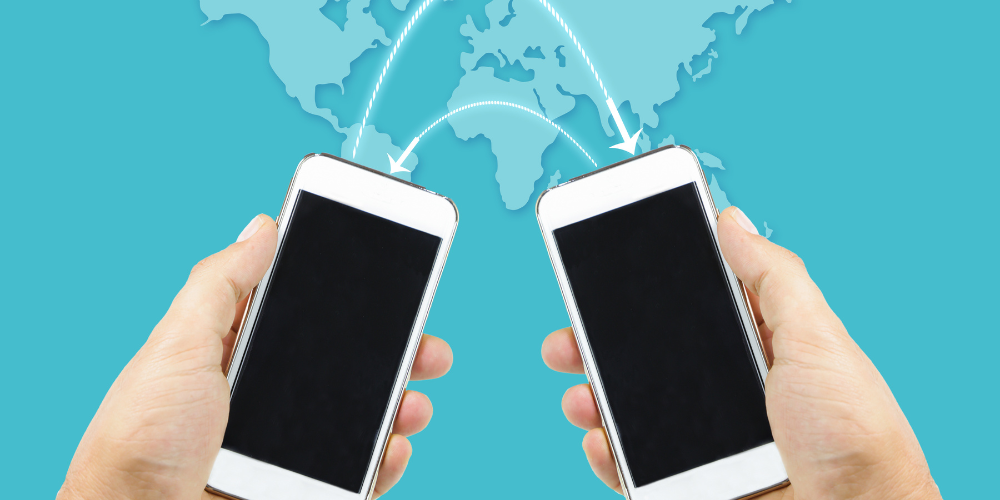What is a Peer to Peer App and how does it actually work ?
Let’s start by defining peer to peer payments from a technical perspective. Electronic funds transfers performed directly from one account to another via a payment application are known as peer to peer transactions. One of the original and most well-known peer to peer payment tools, PayPal, is probably something that everyone has used at least once.
For instance, You set up your account and connect it to your bank or credit card. Additionally, you can transfer money to another person using their email, phone, or account. Usually, passwords or additional information about a sender and a recipient are used to confirm a transaction’s validity. Peer to peer networks allow money transfers between holders of different bank cards without the use of middlemen, which saves you money on commissions. These apps are generally free, however there can be minor costs depending on where your money comes from. Users must have an app available on a smartphone or computer, as well as Internet connectivity, in order to make payments. There are no bank lines or cash confusion. Everything is fairly straightforward.
These apps typically allow money transfers between users of several banks, which simplifies transactions. Depending on the method of payment, processing timeframes can range from a few minutes to several hours. Peer to peer systems have a wide range of applications. These apps allow you to pay for services, make international payments, borrow money, send and accept borrowing requests, and more.
Why should one be engaged in developing a peer to peer application system ?
Peer-to-peer payment apps have had a big impact on the finance landscape users over the past several years. There are currently more than 6 million smartphone users, a significant increase. In the upcoming years, several hundred million more users are anticipated. As a result, there is a rise in demand for fintech that allows consumers to pay without using a card, go cashless, or utilize cash.
What are the advantages of a peer to peer app to the Users ?
- You can make a payment without taking out cash.
- Your app makes it simple to keep tabs on your finances.
- Numerous software programmes offer automatic currency conversion.
- As long as there is an Internet connection, you can make a payment from anywhere in the globe.
- You save money because there are no intermediaries needed.
What are the advantages of peer to peer apps to businesses ?
- You will be able to reach a bigger consumer base and guarantee cost-effective cross-border transactions.
- No intermediaries to charge expensive services.
- You may monetize your app to generate additional revenue from it.
- You can instantly receive money for your services by card or account.
- You will raise user engagement and trust levels.
What are the types of peer to peer payment apps ?
- Standalone services – These peer to peer suppliers have their own mobile peer to peer app solutions that make it easier to transmit money. Every one of them has a wallet function that allows users to keep their money safe before sending it to a bank account or distributing it among their peer network. The top financial services in this category are PayPal and Venmo. With its presence in 202 countries and more than 250 million users, PayPal dominates the list.
- Bank centric – These peer-to-peer payment apps are those that include a bank as one of the parties in the transactions. This category can be further divided into two sorts. One, where each bank has a separate mobile app. Second, peer-to-peer payment apps that transfer money via various financial sector organizations like credit unions, a company that provides financial security, financial institutions, and partner banksOne of the safest platforms ever created by reputable US banking institutions, Zelle complies with all banking sector safety regulations. The Zelle app eliminates the need for any type of account withheld cash by drawing and depositing money immediately into the bank account.
- Mobile OS focused systems – Customers have a tendency to utilize outdated phones or unreliable devices that don’t enable contactless or NFC payments to make purchases in the past. But as clients can now complete transactions more quickly and easily, mobile operating systems have grown to become a popular trend. Customers conduct various banking transactions and pay their bills in significant numbers all across the world. A service provider can monitor emerging cyberthreats in real-time with a mobile OS system and notify clients as soon as they arise. Additionally, it makes payment embezzlement less likely.
- Social media centric – We have seen that numerous social networks and IT companies have created mobile payment apps in recent years. Facebook introduced its payment tool in its messenger in 2015, allowing users to send money inside the app. Four months before Facebook incorporated the online payment feature, Snapchat introduced Snapcash. However, they were forced to discontinue it on August 30, 2018. Following Facebook’s example, Google purchased Softcard, an AT&T, T-Mobile, and Verizon joint venture that provided a mobile wallet platform.
What are the must-have features while building a peer to peer app ?
Electronic wallet – Any payment application must include a digital wallet as its core component. A user maintains his digital currency in a wallet and uses it to make payments. In order to offer a wide range of functionality, digital wallets typically interact with external systems and services as well as the payment card tokenization services from VISA and Mastercard. Before beginning the creation of your software, a separate issue called creating a digital wallet needs to receive specific attention.
Currency conversion – You shouldn’t give up automatic currency conversion because it’s a fantastic feature that makes peer to peer payment apps so well-liked. By adding this feature, you’ll make it possible for your users to transact across borders, pay for services and goods while traveling, and avoid thinking about currency conversion. The most effective approach to use this function is to have your payment app sync with the bank’s currency rate at the moment of the transaction.
Send and request money – In addition to being able to give the desired amount of money, a user should also be able to request money from another user.
Send bills or invoices – Your app should offer a feature for creating a transaction invoice or bill that can be received by both a sender and a recipient for the convenience of a user.
Transfer to a bank account – Users can need to move money across cards as well as between cards and bank accounts. Give them that option.
Using one time passwords or unique IDs – Payment app security is essential. The unique ID and OTP must be confirmed by the user in order to prevent fraudulent or unintended transactions (one-time-password). You can define the requirement that an OTP be entered each time a user logs in if you wish to offer an even greater level of protection.
History of previous transactions – Your users will be able to monitor their spending and money transfers due to the transaction history. Maintain the information for as long as you can. A fantastic solution will also include the capability of creating statements, downloading, and printing transaction history.
Push Notifications enablement – Both you and your users will benefit from push notifications. Notifications of new offers, promotions, or changes will be possible to send. Users will also be able to read messages right away, such as when a card has been credited. Allow consumers to select which notifications they wish to get on their phones, but keep in mind that push notifications can be both helpful and frustrating.
Chatbot – Your peer to peer payment app’s chatbot can enhance user experience. The user can run across issues or questions when using the app. A chatbot will assist in promptly resolving any problems that can occur during fund transfers, improper wallet debits, etc.
Fingerprint security lock – You can set up the fingerprint security lock to reduce the risks related to the security of your application. In this manner, the account can only be accessed by the owner.
What are the steps in building a peer to peer application ?
- Choose a peer to peer app type – There are several types of peer-to-peer payment apps. The most popular are banking and standalone solutions. Depending on the business model you choose, you can stop at one of them, but you should be aware of all types of payment apps.
- Frame a list of features – We need features that are required to be listed so that a development team can estimate their cost. Start with the fundamental functions, and then add any extras you wish to see in your app. You must research your target market, paint a picture of your user, and develop the user flow—the process that users will follow as they engage with your app—if you don’t want to miss anything. Avoid attempting to build every feature at once as this may be unrealistic and too expensive. Prioritize features by concentrating on the essential ones; other features can be added later, after you are certain that they are required.
- Choose the right technology – The choice of technology is the next step. You may increase the functionality and user appeal of a peer to peer payment app with the aid of the appropriate technologies. And you would agree that this is crucial for surviving the competition. NFC and biometric ID were made possible by fintech, but these advancements shouldn’t be our only options. New technologies are emerging as the financial sector continues to undergo digital transformation. For instance, blockchain, unified platforms, artificial intelligence (AI), and real-time payments (RTP). Don’t be afraid to use cutting-edge technologies and tools to construct your app because the quicker, easier, and more lucrative your product is, the greater the likelihood that it will be successful. Blockchain is one of the technologies that has the most potential. Blockchain was originally created to build peer-to-peer systems without the involvement of intermediaries.
- Provide sufficient security level and consider all security issues – Security has previously been brought up, but it is still wise to give it some thought before developing a peer-to-peer payment app. The process of transferring money must be securely protected, as well as any account-related data and the history of your users’ transactions. According to the Cybersecurity Ventures Official Annual Cybercrime Report, the cost of cybercrime will approach $6 trillion by 2021. We’ve already discussed how sending a distinct ID/OTP is necessary for confirming transactions and logging in. This will lessen the likelihood of fraud or unintentional purchases. Try to make advantage of all the device’s security capabilities, such as the fingerprint reader, face recognition, or at the very least, two-factor authentication.
- Regulation Compliance – Security and regulatory compliance are equally essential issues. Payment standards must be followed by your payment app. Although experts claim that the FinTech industry is not sufficiently regulated, certain regions already have laws that must be taken into consideration. Unfortunately, it is very challenging to consider the payment needs of every country and develop a universal app that complies with all criteria. As a result, you should pick a location as your target market and design a peer to peer payment app in accordance with its laws and guidelines.
- Create an effective design – You shouldn’t overlook the design of your app in the quest for legitimacy and functionality. The convenience and user-friendliness of an app for users are determined by the user interface’s proper structure and appealing appearance. A memorable design will likewise support your efforts to raise awareness and involvement. There are various stages in the development of a UX/UI design. Let me remind you that while the UX is in charge of the user’s actual interaction with the interface and his overall perception, the UI is in charge of the general look and feel of an app (colors, layouts, and typography).
- Find a Software Development Team – It’s time to find a skilled development team to work with you to bring your ideas to life now that the preliminary phases are complete. Spend time finding and choosing competent developers. Useful ratings include those from Techreviewer, Clutch, GoodFirms, TopDevelopers, and others. Here are some things to consider while picking a development partner. Appropriate expertise : A corporation must have the expertise and technological capabilities to satisfy your needs. Does a firm, for instance, use blockchain technology? Does it have a track record of creating FinTech projects? Successful projects : In order to observe how the team is handling the work, you should first be interested in FinTech projects that are as comparable to your project as feasible. Customer reviews : Read customer testimonials. This will assist you in discovering a company’s advantages and disadvantages. It takes some work to persuade individuals to spend time writing evaluations since, in all honesty, they don’t really enjoy doing it. Lack of reviews indicates that a business probably doesn’t care about its reputation, which is a bad indicator.
- Test the application – Don’t forget to inquire about the testing results at the project’s conclusion; test the application instead. Finding bugs early and fixing them is preferable to releasing a subpar product onto the market. Testing can help you assess whether your app is functioning as intended, whether it can handle the required load, and whether it is easy to use. Repeat the test as necessary until you are happy with the outcome. A quick checklist for testing your application is provided below.
- Ensure that your program installs and operates properly.
- Verify that a user can carry out common operations.
- Verify that the app operates consistently across all hardware and operating systems.
- Examine the app’s performance during any special events (incoming call, low battery, airplane mode, etc.).
- Test the USB, Bluetooth, WiFi, NFC, and other hardware connections.
- To check for issues and gain user input, test the app with actual users.
- Make a decision regarding who will be in charge of supporting and maintaining the application (dedicated team, outsourcing services).
Keep in mind that a user can form an opinion about your app and decide whether or not to utilise it further
after just a few clicks and swipes. 48% of users say they are less inclined to use an app again if they have
performance problems, according to Compuware. Additionally, customers won’t overlook flaws in your
security, usability, functionality, etc. Alternatives are always available. Never undervalue testing since it can
help you prevent dozens of hazards.
So, now you know where to start developing a peer to peer application.
The final conclusion is :
You are now aware of how peer to peer payment app development works. In addition to deciding which features your app should have, which technologies are best to utilize, and which specifications your product should meet, you have to do a lot of analytical work. So how do you start? Start by identifying the features of your app and conducting user research. Here, your major responsibility is to thoroughly lay out your concept before discussing it with a team of developers who will help you refine and implement it. Pick a talented development team that has experience creating fintech solutions. Take your time when making your decision because the software developers’ skill will determine the quality of your program.
If you are looking for challenging opportunities at some of the fastest-growing global companies, join Talent500. Sign up here.






Add comment